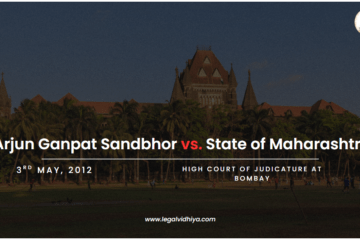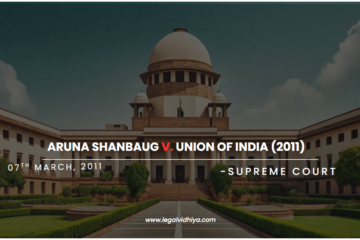
Date of judgment | 01 December 2011 |
Case no | CRIMINAL APPEAL NO.1502 OF 2005 |
Case type | CRIMINALAPPELLATE JURISDICTION |
Petition/appellant | State of Rajasthan |
Defendant/respondent | Shera Ram @ Vishnu Dutta |
Bench | THE HONOURABLE JUSTICE SWATANTER KUMAR & THE HONOURABLE JUSTICE RANJANA PRAKASH DESAI |
Court | THE SUPREME COURT OF INDIA |
Statue referred:
- Section 302 of the Indian Penal Code, 1860.
- Section 295 of the Indian Penal Code, 1860.
- Section 449 of the Indian Penal Code, 1860.
- Section 300 of the Indian Penal Code, 1860.
- Section 84 of the Indian Penal Code, 1860.
- Section 34 of the Indian Penal Code, 1860.
- Section 313 of the criminal procedure code, 1973.
- Section 379 of the criminal procedure code, 1973.
- Section 27 of Indian arms Act, 1959.
Cases referred:
- State of Rajasthan, Through Secretary, Home Department v. Abdul Manna [JT 2011 (9) SC 48 ] (Para 10)
- Inspector of Police, Tamil Nadu v. John David [JT 2011 (5) SC 1] (Para 13)
- Raj Kishore Jha v. State of Bihar & Ors. [JT 2003 (Suppl.2) SC 354] (Para 13)
- State of Rajasthan v. Kalu [1998 SCC (Cri.) 898] (Para 34)
- Ram Jattan and Others v. State of U.P. [1995 SCC (Cri) 169] (Para 33)
- State (Delhi Administration) v. Laxman Kumar & Ors. [1985 (4) SCC 476] (Para 13)
Introduction-
- This appeal highlights the complex nature of contesting acquittal judgments within the domain of criminal law. It centers on the fundamental question of when such interference can be deemed justifiable. In the legal arena, the threshold for interference is intentionally elevated, demanding either a direct contradiction in evidence or a manifestly erroneous perspective by the court.
- Moreover, this discourse delves into the differentiation between appeals against acquittal and those against conviction. Although a disparity exists, it’s not of substantial significance. In appeals against acquittal, the presumption of the accused’s innocence is fortified by their exoneration. Consequently, for an appeal to prosper, it must convincingly establish that the court’s viewpoint is both coherent and rational.
Facts of the case:-
- Before we delve into the merits of the case and the legal issues it encompasses, it is essential to refer to the prosecution’s version. According to the prosecution, on March 10, 1999, around 7:15 a.m., while Pujari Tulsi Das (now deceased) was inside Raghunathji’s temple, the respondent unexpectedly hurled a stone at his head, resulting in his immediate demise. The respondent also inflicted damage upon the temple’s idol and other sacred properties. This incident occurred without provocation and was witnessed by villagers, including PW-6 Santosh, PW-11 Narsingh Ram, and PW-16 Smt. Tiku Devi.
- Section 84, Chapter IV – Offense Under: It should be noted that there is no offense if committed by a person of unsound mind.
- Section 84 – Plea of Insanity – Onus to Prove Insanity – On Whom it Lies: The burden lies with the accused to prove that they suffer from a mental disorder, lack awareness of their actions and their consequences, by presenting expert evidence. (Para 20)
- Sections 302, 84, 295, 449 – Murder by Hurling a Stone at the Deceased’s Head – Witnessed by PWs. 6, 11, and 16, among others – Conviction by the trial court – Insanity claimed and accepted by the High Court, leading to acquittal – DW 2, Doctor R, examined and treated the accused – Examination report filed – Even in jail, medical treatment was provided – On the day of the incident, the accused was in the post-epileptic attack stage, during which he damaged an electricity meter and a bulb, and struck DW 1’s arm and face. It is held that there is ample evidence to conclude that the accused was mentally ill, and there is no error in the High Court’s judgment.
- Section 302 – Murder – The prosecution’s case is that the accused hurled a stone, causing an injury to the deceased’s left forehead, leading to his fall and collapse – Neither the prosecution’s case nor Doctor C, PW 20’s deposition confirm that the injury was sufficient, in the ordinary course of nature, to cause death. Whether this deficiency casts doubt on the prosecution’s case and whether the accused is entitled to acquittal based solely on this ground – There is no documentary or oral evidence to prove that the injury inflicted by the accused was naturally fatal. It is held that whether the injury was naturally fatal or not is a factual question to be determined based on the facts, circumstances, and evidence presented.
- Epileptic Psychosis – Disease – Post-Epileptic Insanity – Behavior of a Patient After an Epileptic Attack: Stated.
- Maxim – Furiosus Nulla Voluntus est: It is held that a person suffering from a mental disorder cannot be deemed to have committed a crime, as they do not comprehend the nature of the act, or that it is wrong or against the law, due to unsoundness of mind.
- After an epileptic attack, a patient may behave erratically and be unable to recognize even familiar individuals and relatives. Memory loss occurs during this period, and the patient may engage in criminal behavior. Ext. D-3, issued by Dr. Ashok Pangadiya, indicated that the patient suffered from epilepsy and displayed symptoms of behavioral abnormalities.
- According to DW1, the respondent had been afflicted with a mental disorder since 1993. He mentioned that during episodes of insanity, the respondent could engage in physical altercations, striking anyone in his vicinity and even throwing objects. On the day of the incident, around 6:00 – 6:30 a.m., Shera Ram/respondent was unwell and in poor condition. He had previously damaged the electricity meter and bulbs at home. When family members, including the witness, attempted to restrain him, he assaulted DW-1 on the arm and, after hitting his face, fled.
- Both oral and documentary evidence clearly demonstrate that the respondent had suffered epileptic attacks shortly before the incident. Immediately preceding the occurrence, he had displayed violent behavior and caused harm to his own family members. Following the commission of the crime, he was apprehended by the police and received treatment for insanity while in custody.
Issue:
- The legal question pertains to the burden of proving insanity and behavioral abnormalities following epileptic attacks.
- Whether considering the absence of documentary or oral evidence establishing the injury’s natural fatality.
Judgment:
“The Appeal was dismissed”
- There is no documentary or oral evidence to establish whether the injuries inflicted by the respondent upon the deceased were of such a nature that they could have caused death in the ordinary course of events. However, it’s important to note that this cannot be asserted as an absolute legal doctrine. Whether a specific injury had the potential to cause death in the ordinary course of events is a matter of fact that must be determined based on the circumstances, evidence, and facts presented in each case .There may be instances where injuries sustained by the deceased could inherently lead to the inevitable conclusion that they were sufficient to cause death in the ordinary course of events. Conversely, in other cases, it may be necessary to establish this through documentary and oral evidence. Consequently, the outcome will always hinge on the particulars of each case. Therefore, it may not always be feasible or permissible to state a universally applicable absolute legal principle in such cases.
- Considering the preceding discussion, we do not identify any errors in the judgment being challenged. Consequently, we do not hesitate to reject the appeal, which is hereby dismissed.
Conclusion:
- This case revolves around a tragic incident where the accused allegedly caused the death of Pujari Tulsi Das and damaged a temple’s idol and sacred items by hurling a stone. The accused claimed to be mentally ill and, therefore, not responsible for the act. The High Court accepted this claim and acquitted the accused.
- The law states that a mentally unsound person cannot be held criminally responsible. However, it’s crucial to determine whether the injuries inflicted by the accused could naturally lead to death. This is a factual question, and in some cases, it may be obvious, while in others, it requires expert and other evidence.
- In this case, evidence showed that the accused had a history of epilepsy and erratic behavior. He was in a post-epileptic state during the incident, causing damage and assaulting family members. Medical records supported his mental disorder. However, it was unclear whether the stone’s impact could naturally cause death.
- In conclusion, the judgment of the High Court was upheld because there was sufficient evidence of the accuser’s mental illness. However, the question of whether the injuries were naturally fatal remains a matter of fact in each case. This case illustrates the complexity of balancing mental health issues with criminal responsibility.
Written By Jhalak varshney, Lloyd Law College, Greater Noida.



0 Comments